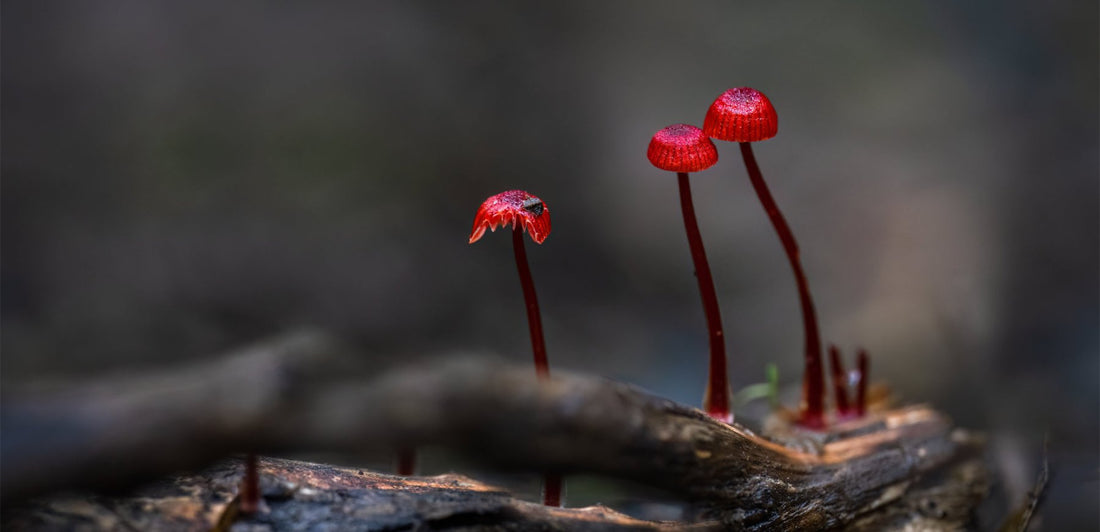Being a sustainable fashion brand that puts ocean protection above all else, everyone here at TWOTHIRDS is constantly looking at ways to improve our products and our supply chain, so that we continue on our mission to become truly climate positive. This usually means deep diving into the pros and cons of using LENZING™ ECOVERO™ viscose instead of regular viscose, opting for organic cotton instead or standard cotton, or ensuring that all our eco-friendly clothes are made in Europe rather than further afield (as is the case with many other supposedly sustainable fashion brands).
However, now and again a topic connected to earth systems or wider environmental protection – beyond the sustainable fashion industry – catches our eye. Such was the case with an incredible study published in Current Biology, which showed why fungi (aka mushrooms) could be unexpected allies of the ocean and marine ecosystems. Let’s take a look at how fungi could help save our oceans, as well as providing inspiration and new ideas for an eco-friendly clothing brand like TWOTHIRDS.
Look What These Mushrooms Can Do!
The headline stat from this study, undertaken by an international team of scientists, is that fungal networks across the globe sequester an estimated 13.12 gigatons of CO2 annually. That is around a third of the CO2 emitted from the burning of fossil fuels each year. This is a truly staggering amount and shows that the humble mushroom could be instrumental in bringing climate change under control.

How Does This Help The Ocean?
Prior to this discovery it was thought that other precious ecosystems like rainforests and the ocean were the planet’s main carbon sinks. According to the UN, the ocean currently absorbs 25 percent of all carbon dioxide emissions, creates 50% of the world’s oxygen, and helps cool the planet to boot. But now it’s clear that pressure can be taken off this already overburdened ecosystem if humanity does everything it can to help fungal networks grow and prosper. The great thing is that fungi can even help keep soil and other plants healthy at the same time!

How Can Slow Fashion Lend A Hand?
One of the reasons this study is so important is because it shines a light on a crucial natural resource that until now has been hugely undervalued and misunderstood, and which is also facing multiple man-made threats. The first of these is soil degradation. This is caused by deforestation, overfarming, climate change, and the use of toxic pesticides and fertilisers. All of these can combine to degrade soil so that it’s difficult for fungal networks to thrive in, thus making it equally tough for plants, and the wildlife that rely on them, to flourish.
It’s here that slow fashion practices can begin to make a genuine difference. By doing everything possible to only work with organic cotton, we ensure that no harmful pesticides or fertilisers are used in the farming of our cotton, and that as little water as possible is used to cultivate it. The same is true of the flax that’s harvested to create our beautiful linen sustainable trousers, eco-friendly shirts and ethical jackets, because not only does flax cultivation have a lower environmental impact than that of cotton or other commonly used materials, it even acts to enrich soil rather than degrading it.
There are many more instances of eco-friendly fashion fabrics lending a helping hand to fungi; indirectly aiding the ocean in its fight against climate change.
Could We Make Eco Clothes From Mushrooms?
Aside from the incredible environmental impact that mushrooms and their mycelium networks can have when it comes to sequestering carbon, there is even mounting evidence that mushrooms could become one of the leading sustainable fashion fabrics of the future.

On our never ending quest to seek out the most eco-friendly fashion fabrics, one type of fabric keeps popping up again and again: that of fungi-based fabrics. Some of the more notable ones include Mylo, Muskin and MycoTEX, with Mylo having recently been put under the bright lights of fashion runways by none other than Stella McCartney. This more eco-friendly and animal-friendly alternative to leather is certainly on the radar of our expert slow fashion designers. As soon as we release a mushroom-inspired sustainable jacket or eco-friendly top, we’ll be sure to let you know.
The Last Of Us - Unfair On Fungi

To conclude, it’s clear that along with forests and our beloved ocean, fungal networks such as the ones mentioned in this article will be crucial to creating a truly sustainable planet for all. Anyone who watched The Last Of Us could be forgiven for thinking that fungi might one day be an existential threat to humankind, but actually the opposite appears to be true, with fungi key to reducing climate breakdown. Fungi could even help create the sustainable jackets and eco-friendly trousers of tomorrow.








